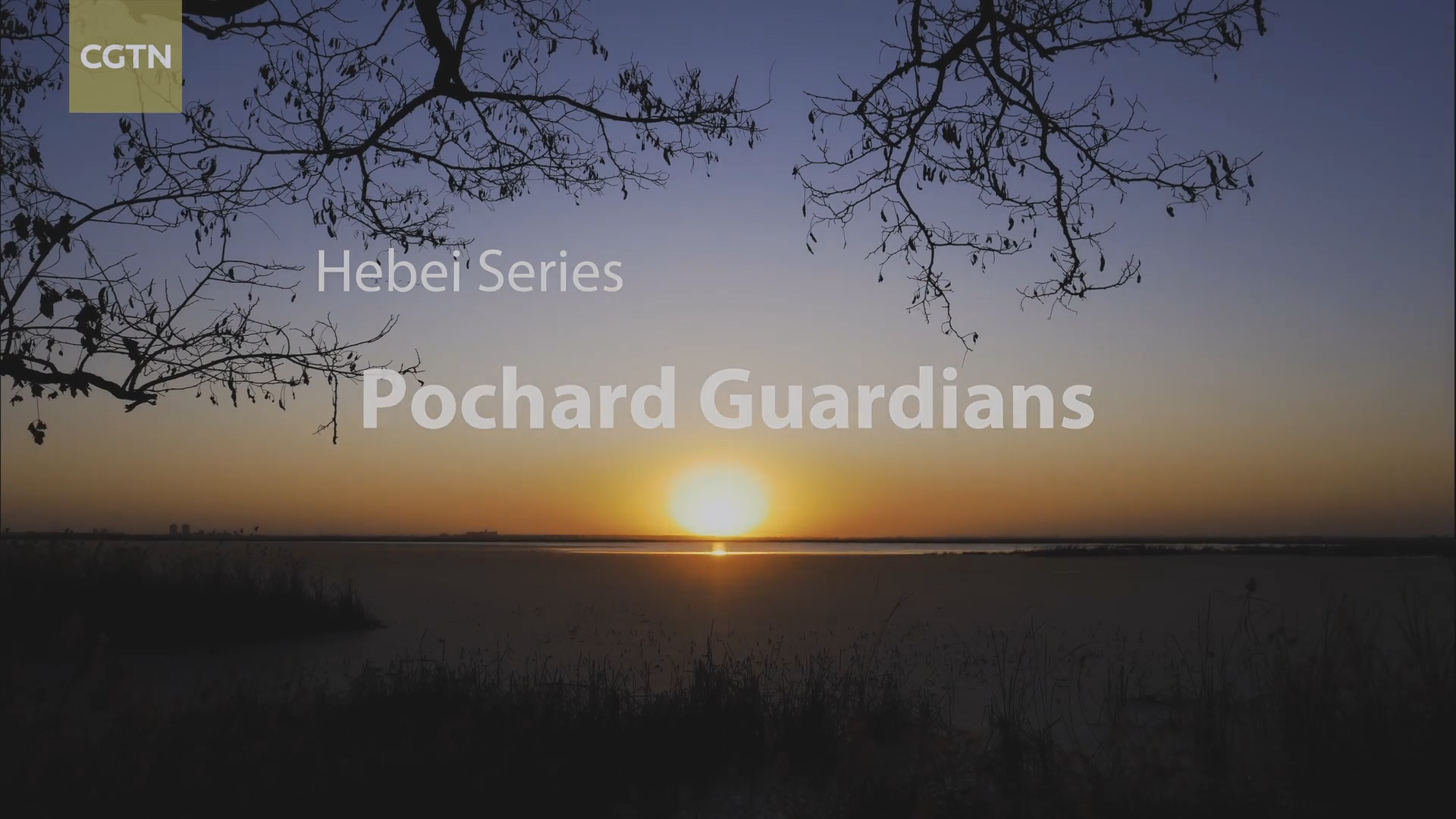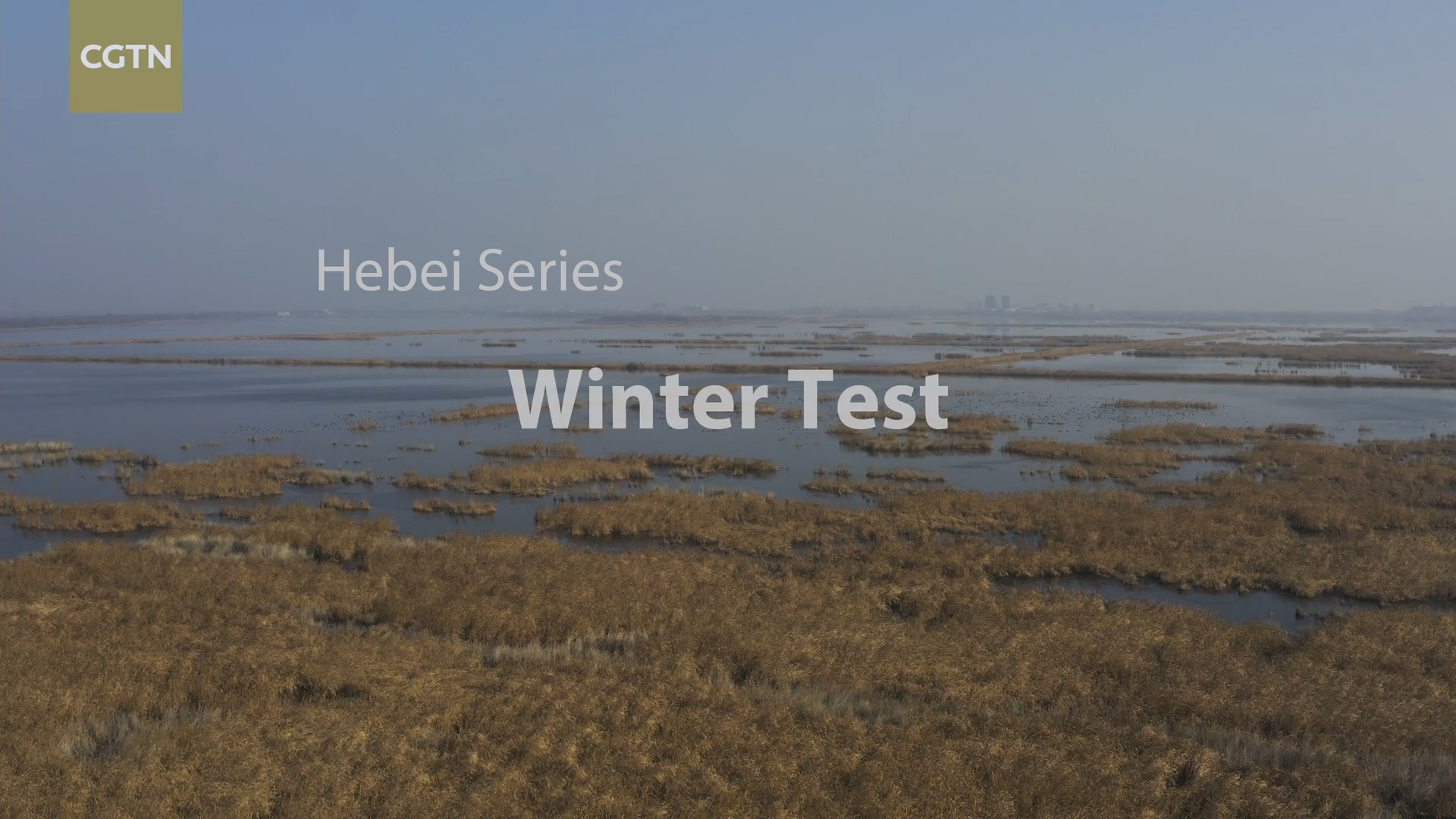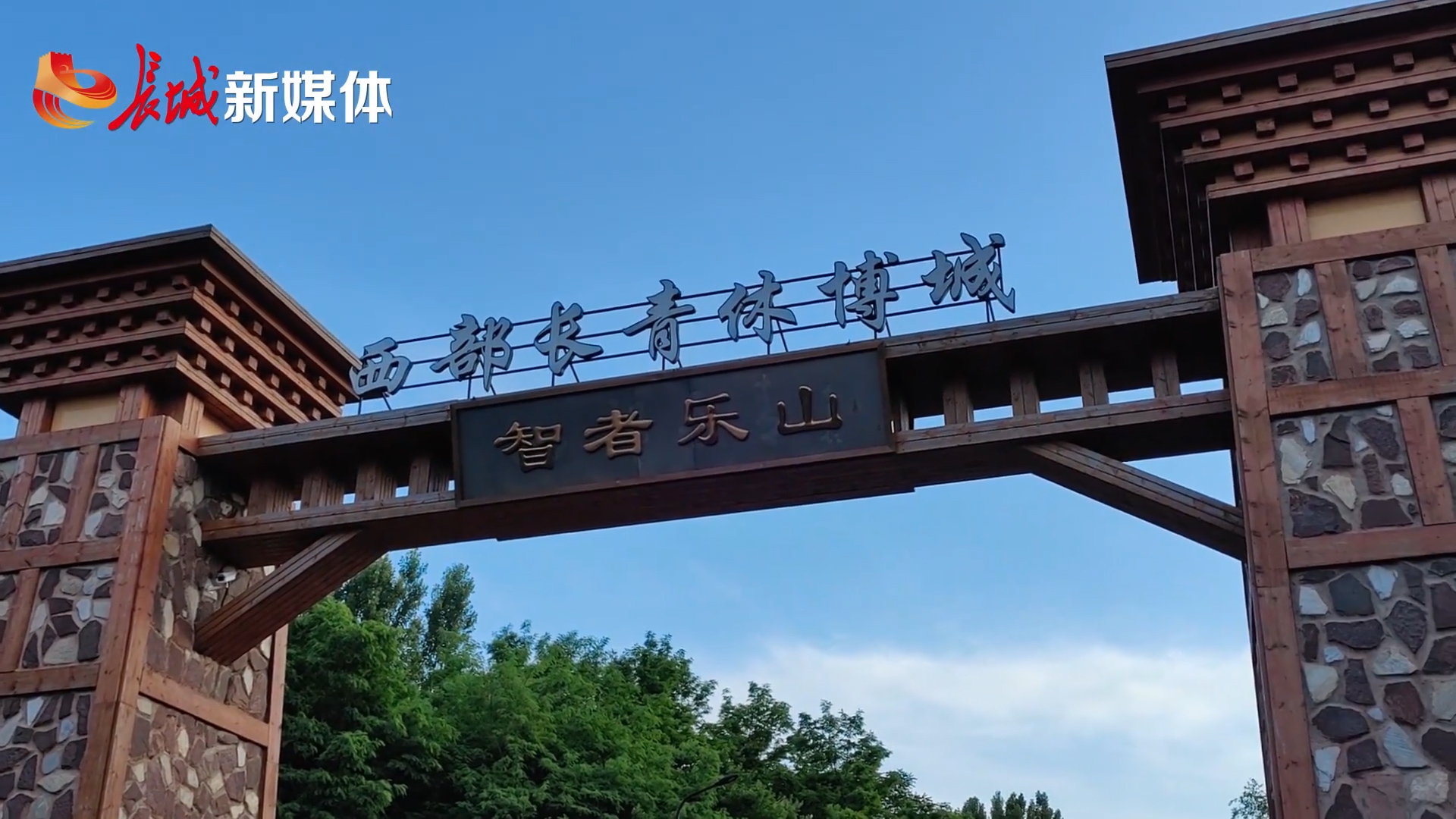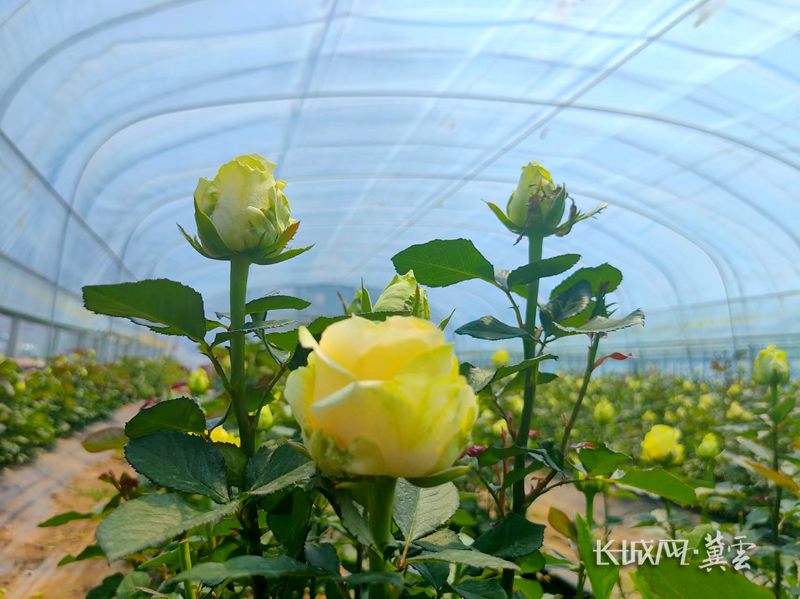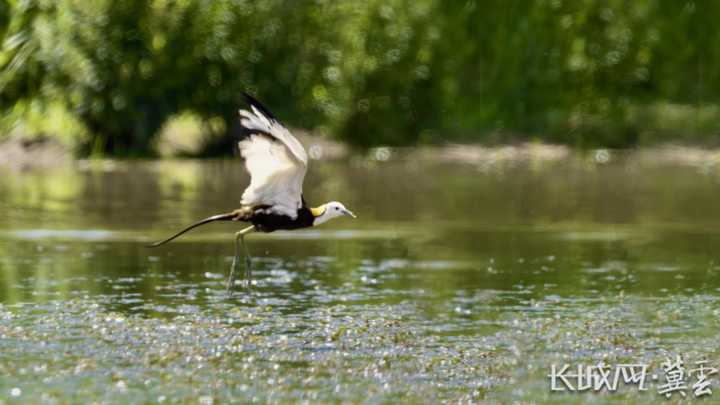金秋九月,天高云淡。9月20日,在河北涉县王金庄村,玉米、谷子、高粱渐次成熟,黄绿交错的旱作石堰梯田随山势绵延,一望无际,构成了别具一格的壮丽景观。
In golden autumn, the sky is high and the clouds are pale. On September 20, the Wangjinzhuang Village, Shexian County, Hebei Province was elated to see their corn, millet, and sorghum ripening. The yellow and green dry crop stone terraces surrounded by weirs are extending right down from the mountain, seemingly boundless, constituting a unique splendid landscape.
涉县位于晋冀豫三省交界,是典型的太行山区深山县。全县荒山多、耕地少、水源缺,素有“八山半水分半田”之称。面对恶劣的自然环境,当地农民就地取材,用山石筑堰,在石堰间填土造出片片田地。
Located in the junction of Shanxi, Hebei and Henan provinces, Shexian County is typically a place deep in the Taihang Mountains. The whole county has mostly barren mountains, but limited arable land, short of water sources, reputed as "having 80 percent of mountain, 5 percent of water sources and 15 percent of cropland". Despite such harsh natural environment, local farmers have made full use of the locally available resources to build stone weirs, filling up the spaces inside to plant crops.
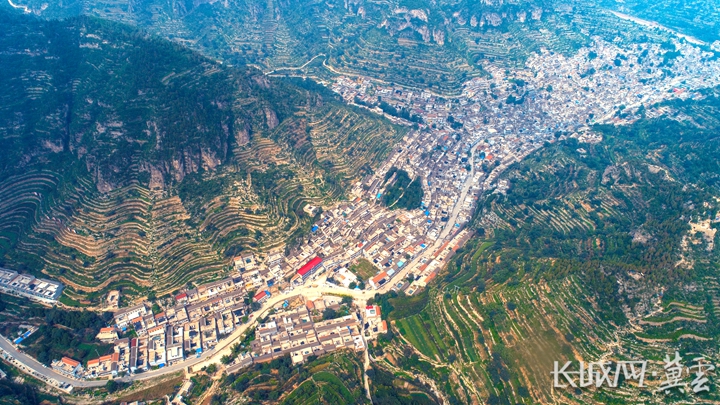
河北涉县旱作梯田系统是北方旱作石堰梯田最具代表性的系统之一,其中规模最大的梯田位于井店镇王金庄区片。杨彦忠 摄
The Shexian Dry-crop Stone Terrace System is the most representative in northern China. The largest of all is that in the Wangjiazhuang Village of the town of Jingdian. (Photo by Yang Yanzhong)
山有多高、堰垒多高。”涉县农业农村局副局长贺献林告诉记者,涉县的旱作石堰梯田至今已有超过700年历史,经过世世代代的修建,梯田从山脚层层叠叠直达山顶,除了悬崖陡壁,7成以上的坡面都被利用了起来。目前,石堰梯田系统面积达204.35平方公里,涵盖46个行政村,在给当地人提供了稳定生计的同时,也保持了水土、改善了环境。
"The terraces have reached up to the top of the mountain”said He Xianlin, deputy director of the Shexian County Agricultural and Rural Affairs Bureau. The terraces have a history of over 700 years. Built by the local people from generation to generations, the terraces start from the foot of the mountain to reach up to the top, covering more than 70 percent of the slopes, except the steeples and cliffs. At present, the terrace system covers 204.35 square kilometers, benefitting 46 administrative villages. While securing a stable livelihood for the local people, they have the functions of conserving soil and water and improving the environment.
“在我们这,土比金贵,祖祖辈辈种植梯田的土,都是从石头缝里抠出来的。哪怕鞋子里有点土,都要倒回田里。”王林定是土生土长的王金庄人,每每看到祖辈留下的梯田被撂荒,他都心疼不已。
"In our place, soil is dearer than gold. The soil on the terraces has been dug out from the crevices of stones. The people take soil so dearly that they even put back to the field the dust in their shoes,”said Wang Linding, a native farmer of the Wangjinzhuang Village, adding that he feels heart-ache to see the terraces left by the forerunners go barren and wasted.
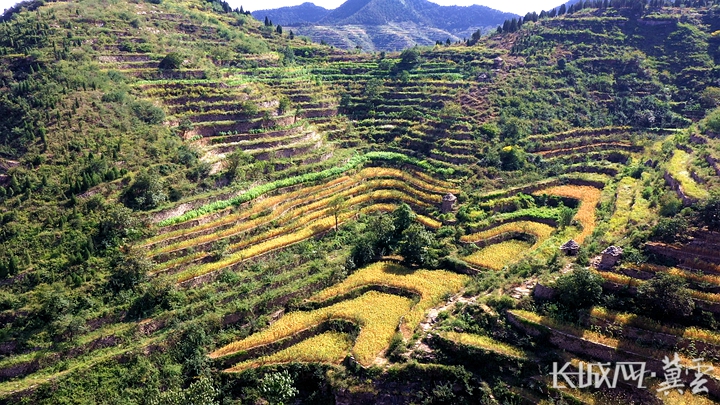
在河北涉县王金庄村,秋日的梯田如链似带,层层叠叠,线条分明,宛若大地的“调色盘”。长城网·冀云客户端记者 邓光韬 摄
In Wangjinzhuang, the terraces in autumn are like necklaces or ribbons, layer upon layer, with clear lines. They look like a giant "palette"on the land. (Photo by Deng Guangtao/Great Wall New Media)
在王林定记忆中,十几年前,村里的青壮年都出去打工,山上的田荒了不少。“后来政府带着大家保护梯田、修复生态,太行山高速公路通车后,田里的小米、花椒卖到全国各地,我们的‘石田’又活了,很多年轻人也回来了。”言语间,流露出对生他养他的这片土地的挚爱。
In Wang Linding's memory, many of the young people in the village left their hometown to find jobs in other places, leaving many terrace fields barren and wasted.
"Later, the local government led the people in protecting the terraces and restoring the ecology. When an express highway was built on the Taihang Mountains, they are able to sell millet and wild pepper to other places. Our stone weir fields began to revive and many young people have returned,”said Wang Dinglin, revealing his strong love for this piece of land where he was born and grow.
“喔喔……嘚嘚……”一声声吆喝响起,王林定和妻子牵着毛驴又开始一天的劳作。“我家这片田种的都是老黄谷,熬出粥来米油多、口感好,吃起来别提有多香!”王林定捧着金黄饱满的谷穗笑得合不拢嘴。
Wang Linding and his wife are driving their donkey to start a day's work.“We have planted in this piece of land Laohuanggu (millet), which has abundant liquid floating on the surface of the gruel cooked and tastes good. It could hardly imagine how pleasant it tastes,”said Wang Linding, holding the plump millet ears and grinning from ear to ear.
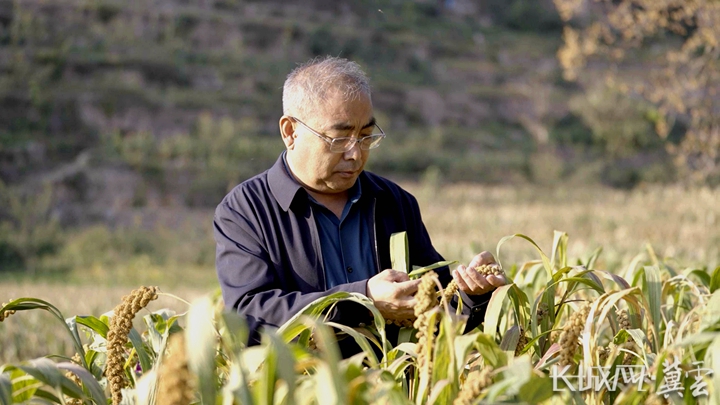
9月20日,涉县农业农村局副局长贺献林在旱作石堰梯田观察记录老品种的生长情况。长城网·冀云客户端记者 邓光韬 摄
On September 20, He Xianlin is observing and recording the growth of old varieties in the terraces. (Photo by Deng Guangtao/Great Wall New Media)
"谷粒饱满,秆壮、穗大,这个老种子总算留住了。”沿着山坡缓行,贺献林不时停下查看梯田中黑软谷的长势。“前些年,像黑软谷这样的传统农作物品种在王金庄已经消失了,通过走访调查,我们在其他村庄发现还有小范围种植。我们就把收集到的种子播种到了老品种提纯复壮基地,并纳入‘农民种子银行’进行管理。”
"The grain is full. The stalk is strong. The ears are long and big. The old seed has been preserved at last," said He Xianlin, walking slowly along the slope, stopping from time to time to see the crop.
"Over the past few years, such traditional species like Heiruangu, disappeared here. After investigations, we found that it was planted on a small scale in other villages. Then we collected some seeds and sowed them in the base for purification and rejuvenation of old species,”He said.
58岁的贺献林已经和梯田打了20多年交道,一直致力于旱作石堰梯田的保护与利用。在他眼中,老种子代表了当地丰富的生物多样性,是传承农耕文明的重要载体。在王金庄“农民种子银行”,已经收集管理的农业物种有26科57属77种,很多品种的种植历史都在百年以上。
The 58-year-old He Xianlin has been working in the terraces for more than 20 years, dedicating his energy to the protection and utilization of stone terraces. To him, old seeds represent the abundance of biodiversity in the local area and are an important carrier of farming civilization. The Wangjinzhuang Seed Bank has collected and managed seeds covering 26 families, 57 genera and 77 species, many of which have a history of over 100 years.
“我们通过对传统作物品种的普查、收集,保存传统作物的遗传基础基因,进而利用其基因选育优良新品种,带动农业增效、农民增收。”贺献林和他的团队这些年先后提纯复壮了小黑豆、红软谷等60余个老品种,让它们重新回到梯田生长,在保证品质的前提下,产量还有所提升。
"By surveying and collecting traditional species, we have preserved the basic genetic genes of traditional species and gone on to use their genes to select and cultivate new varieties so as to increase yields and the income for farmers,”said He.
He Xianlin and his team have purified and rejuvenated more than 60 old varieties, such as Xiaoheidou (black grains) and Hongruangu (millet), making them grow back in the terraces, ensuring that they increase yields with better quality.

河北涉县旱作石堰梯田系统不仅提供了丰富的食物种类,同时在土壤、水和生物多样性保护方面发挥着重要作用。长城网·冀云客户端记者 段维佳 摄
The terrace system has not only provided abundant varieties of food, but also played an important role in conserving soil, water and biodiversity. (Photo by DuanWeijia/Great Wall New Media)
近年来,涉县积极开展石堰梯田保护发展。“在梯田周边造林,主要是为了保持水土,避免自然灾害。”涉县林业发展服务中心一级主任科员李和保介绍,从上世纪90年代至今,他们通过补植和区块造林的方式,持续开展梯田生态综合治理,种植连翘等经济林,在提升土地附加值的同时还绿于民。
In recent years, Shexian has made great efforts to protect and develop the terrace fields.“We have planted trees around the terraces to conserve water and soil and ward off natural disasters,”said Li Hebao, first-class senior section member of the Shexian Forestry Development Service Center.
From the 1990s to the present, they have carried out integrated control of the ecology of the terraces by planting trees. They have planted such medicinal herbs as Weeping Forsythia Capsule to raise the added value of the land.
“当地农民都有了保护生态的意识,不再到山上放羊、割柴,自觉减少对自然环境的干预破坏。”李和保兴奋地说,生态的改善让野鸡、獾、粉葛等野生动植物再次出现,传达出了人与自然和谐共生的积极信号,让这片古老的石堰梯田焕新颜、展新姿。
"All local farmers are well aware of protecting the ecology. They no longer herd their sheep on the mountain or cut firewood, conscientiously reducing the artificial intervention and damage to the natural environment,”said Li Hebao.
The improvement in the ecology has lured back such wild animals as pheasant and badger and such wild plant known as Edible Kudzuvine Root, indicating the harmonious co-existence between man and nature. This ancient stone weir terraces have put on a new look and displayed its new posture.
在相距王金庄村不到5公里的刘家村,乡亲们正忙着挑拣晾晒好的花椒。90后自媒体人“农村阿凯”在一旁做着直播带货:“都说我们涉县的花椒十里香,大家看看,粒粒鲜红、饱满油亮……”
In the Liujia Village, less than five kilometers away from Wangjinzhuang, the local people are busy selecting and airing out pepper, with the We Media worker "Rural A'kai" nearby doing livestreaming marketing.
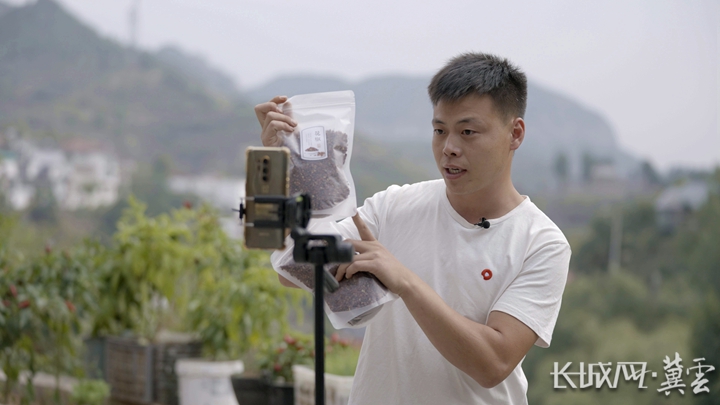
河北涉县“90后”小伙刘志凯,把祖辈留下来的梯田风光拍成短视频发到网上,让更多的人知道自己的家乡。长城网·冀云客户端记者 段维佳 摄
Liu Zhikai, a post-90s young man in Shexian County, has made a short video of the terraces and uploaded it onto the Internet to make it known to more people. (Photo by Duan Weijia/Great Wall New Media)
“农村阿凯”本名刘志凯,是刘家村人,过去多年在外务工,2016年他返乡创业,逐渐成为一位小有名气的自媒体人。这些年,他用镜头记录下家乡梯田的变迁,制作出上千条短视频,在网上收获了183万“粉丝”。
"Rural A'kai" is the nickname of Liu Zhikai, a member of the Liujia Village. He used to work in a city for many years. He returned home in 2016 to start up a business, gradually becoming a We-Media worker. He has recorded with his camera the changes in the hometown terraces and made a thousand micro videos, which have attracted 1.83 million fans.
搭上网络短视频的快车,刘志凯除了宣传家乡美景,还为家乡的农产品销售出了一把力。“去年我们卖出小米3万斤、花椒2500斤,收入10多万元。”看着乡亲们靠梯田过上好日子,他干劲更足了。
By using the network short videos, Liu Zhikai has not only disseminated the beautiful landscapes of his hometown but also contributed to the marketing of local farm produce. "Last year, we sold 15,000 kilograms of millet, 1,250 kilograms of pepper, collecting an income of more than 100,000 yuan,”said Liu, who has become even more enthusiastic when seeing his folks living a better life by relying on the terraces.
今年5月20日,涉县旱作石堰梯田系统被联合国粮食及农业组织正式认定为全球重要农业文化遗产。
On May 20, 2022, Shexian terrace system was officially recognized by the UN Food and Agriculture Organization and was inscribed in the list of Globally Important Agriculture Heritage Systems.
Editor: Li Wenpei


